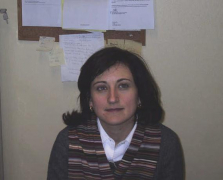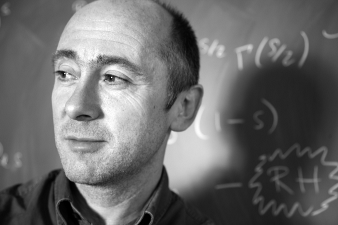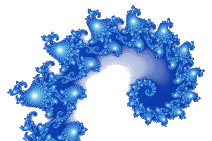 11/05/2017, 16:00 — 17:00 — Abreu Faro Amphitheatre, Interdisciplinary Complex
11/05/2017, 16:00 — 17:00 — Abreu Faro Amphitheatre, Interdisciplinary Complex
Leonor Godinho, IST - ULisboa
Para além de 12 e 24
A geometria simpléctica e a matemática discreta estão fortemente interligadas devido à existência de acções hamiltonianas de toros. Estas acções estão associadas a uma aplicação (denominada aplicação momento) que transforma uma variedade simpléctica compacta num polítopo convexo. Nesta palestra vamos concentrar-nos numa classe de polítopos, definida por Batyrev no contexto de simetria-espelho e que tem atraído muita atenção recentemente: os polítopos reflexivos. Em particular, vamos ver como as famosas propriedades "12 e 24" em dimensão 2 e 3 podem ser generalizadas com a ajuda da geometria simpléctica.
See also
Poster
 18/03/2014, 10:30 — 11:30 — Room P3.10, Mathematics Building
18/03/2014, 10:30 — 11:30 — Room P3.10, Mathematics Building
Jon Keating, University of Bristol
Random Matrices and Number Theory
I will review conjectural connections between some important problems in analytic number theory, such as the Riemann Hypothesis, and random matrix theory, which plays a significant role in many areas of mathematical physics. These connections have had a major impact on our understanding of number-theoretic \(L\)-functions (e.g. the Riemann zeta-function).
23/07/2013, 16:00 — 17:00 — Room P3.10, Mathematics Building
Vladimir Voevodsky, Institute for Advanced Study
Univalent Foundations of Mathematics
I will outline the main ideas of the new approach to foundations of
practical mathematics which we call univalent foundations.
Mathematical objects and their equivalences form sets, groupoids or
higher groupoids. According to Grothendieck's idea higher groupoids
are the same as homotopy types. Therefore mathematics may be
considered as studying homotopy types and structures on them.
Homotopy type theories, the underlying formal deduction system of
the univalent foundations allows one to reason about such objects
directly.
14/05/2013, 10:30 — 11:30 — Room P3.10, Mathematics Building
Alessio Figalli, University of Texas at Austin
Stability results for sumsets in \(\mathbb{R}^n\)
Given a Borel set \(A\) in \(\mathbb{R}^n\) of positive measure,
one can consider its semisum \(S=(A+A)/2\). It is clear that \(S\)
contains \(A\), and it is not difficult to prove that they have the
same measure if and only if \(A\) is equal to his convex hull minus
a set of measure zero. We now wonder whether this statement is
stable: if the measure of \(S\) is close to the one of \(A\), is
\(A\) close to his convex hull? More in general, one may consider
the semisum of two different sets \(A\) and \(B\), in which case
our question corresponds to proving a stability result for the
Brunn-Minkowski inequality. When \(n=1\), one can approximate a set
with finite unions of intervals to translate the problem onto
\(\mathbb{Z}\), and in the discrete setting this question becomes a
well studied problem in additive combinatorics, usually known as
Freiman's Theorem. In this talk I'll review some results in the
one-dimensional discrete setting, and show how to answer to this
problem in arbitrary dimension.
03/07/2012, 16:30 — 17:30 — Room P3.10, Mathematics Building
Raymond Chan, The Chinese University of Hong Kong
Tight-frame Approach for Image Processing
In many practical problems in image processing, the observed
data sets are often incomplete in the sense that features of
interest in the image are missing partially or corrupted by noise.
The recovery of missing data from incomplete data is an essential
part of any image processing procedures whether the final image is
utilized for visual interpretation or for automatic analysis. In
this talk, we present our tight-frame algorithm for missing data
recovery. Tight-frames are extension of wavelets. They generalize
orthonormal wavelet systems and give more flexibility in filter
designs. We begin our talk with an introduction of tight-frames.
Then we illustrate how to apply the idea to different image
processing applications such as inpainting, impulse noise removal,
super-resolution image reconstruction and video enhancement.
Joint work with X. M. Yuan (Hong Kong Baptist University) and J.
F. Yang and M. Tao (Nanking University).
31/05/2012, 16:30 — 17:30 — Room P3.10, Mathematics Building
Richard Wentworth, University of Maryland
Topology of representation varieties of surface groups
This will be a survey talk on some aspects of the geometry and
topology of moduli spaces of representations of surface groups into
Lie groups. I will discuss recent generalizations of the techniques
of Atiyah and Bott on equivariant Morse theory. These extend
results on stable bundles to Higgs bundles and associated moduli
spaces, which correspond to representation varieties into
noncompact Lie groups.
29/06/2011, 16:30 — 17:30 — Amphitheatre Pa1, Mathematics Building
Ron Douglas, Texas A&M University
Operator Theory and Complex Geometry
One approach to the study of multivariate operator theory on Hilbert space is the study of algebras of operators. Many algebras of operators act on natural Hilbert spaces of holomorphic functions defined on some complex domain in . Examples are the algebras of bounded multipliers on the Hardy and Bergman spaces for the unit ball and polydisk in . One approach to the study of such algebras is to adapt the complex geometric methods of M. Cowen and the author to the context of Hilbert modules over the polynomial algebra in several variables. In this talk, I will describe this line of study with an emphasis on concrete examples as well as a focus on several results in operator theory whose proof rests on concepts and techniques from algebraic and complex geometry.
05/05/2011, 16:30 — 17:30 — Amphitheatre Pa1, Mathematics Building
Tudor Ratiu, École Polytechnique Fédérale de Lausanne
The geometry of the equations of motion in continuum mechanics
I plan to link the basic equations appearing in rigid body dynamics, fluid mechanics, elasticity, and liquid crystals to reduction theory of Lagrangian systems with symmetry. One of the goals is to compare the equations appearing in the spatial and convective representations. A second goal is to show how this geometric approach leads to answers to some basic questions appearing in continuum mechanics. For example, it will be shown how to relate the Ericksen-Leslie director theory to the Eringen micropolar approach to the equations of motion for liquid crystals, a problem that has been open for the past thirty years.
10/03/2011, 16:30 — 17:30 — Amphitheatre Pa1, Mathematics Building
Arnaud Beauville, Université de Nice
Holomorphic symplectic geometry
The usual structures of symplectic geometry (symplectic, contact, Poisson manifolds) make sense in the holomorphic set-up; they turn out to be quite interesting on projective (or compact Kaehler) manifolds. I will describe why these structures appear naturally, review some of the results obtained recently and discuss the main open problems in the subject.
10/02/2011, 16:30 — 17:30 — Amphitheatre Pa1, Mathematics Building
Rahul Pandharipande, Princeton University
Cohomology of the moduli space of curves
The moduli space of curves is an object which has been studied since Riemann. After reviewing basic aspects of the geometry of moduli space, I will discuss recent progress in understanding of its cohomology.
20/01/2011, 17:00 — 18:00 — Amphitheatre Pa1, Mathematics Building
Philip Candelas, Mathematical Institute, University of Oxford
Periods of Calabi-Yau Manifolds in Physics and Number Theory
Calabi-Yau manifolds have many remarkable properties owing to their relation to string theory and supersymmetry. Every CY manifold has a holomorphic three-form and the integrals of this three form over a basis of three-cycles yield the periods of the manifold. The aim of the talk is to explain why two separate communities think that they "own" the periods. Physicists require the periods to calculate quantities pertaining to elementary particle interactions and number theorists know that the periods contain important arithmetic information about the manifold.
04/11/2010, 16:30 — 17:30 — Amphitheatre Pa1, Mathematics Building
Angus Macintyre, Queen Mary, University of London
Schanuel's Conjecture and exponential equations over the reals and complexes
Schanuel's Conjecture from transcendental number theory explains all known and expected results containing algebraic independence of values of the complex exponential function. I will explain how it connects to algorithmic questions about systems of exponential equations over the reals and complexes, as well as to old questions in complex analysis, such as Shapiro's Conjecture.
14/10/2010, 16:30 — 17:30 — Amphitheatre Pa1, Mathematics Building
John B. Conway, The George Washington University
Subnormal operators and function theory
Abstract. This is a survey of some results illustrating the intimate connection between the theory of subnormal operators on a Hilbert space and the theory of analytic functions. Analytic functions help to unearth some structure of the operators, and the operator theory prompts us to ask certain questions about analytic functions. A good interaction.
04/06/2009, 16:30 — 17:30 — Amphitheatre Pa1, Mathematics Building
Pierre Cartier, IHES
The Life and Work of Grothendiek
Alexander Grothendieck is recognized as one of the greatest mathematical geniuses of the 20th century, and one of the most fascinating personalities. There are four phases in his life.
- A very difficult youth. Born in 1928 in Berlin from anarchist parents, a Russian Jewish father and a German mother, he was left behind in Nazi Germany at the age of 5 in a foster family, whom he revered deeply. Reunited with his mother in Paris in the year 1938, he (and his family) endured the hardships of the war and political camps, first under French, and then Nazi rule. His father died in Auschwitz, he and his mother survived through the help of antifascist huguenots resistants. After graduating from high school, he became for a short period a student in the University of Montpellier.
- His mathematical golden age. After meeting Henri Cartan in Paris in 1948, he worked on his doctoral thesis under the guidance of Jean Dieudonné and Laurent Schwartz (in Nancy). After defending his thesis in 1953, about problems of Functional Analysis, he went to Brazil, and concentrated on new mathematical directions. In a few years, he revolutionized algebraic geometry and homological algebra, by his various inventions: abelian categories, cohomology of sheaves, schemes, and general complex-analytic spaces. With Dieudonné, he was among the first professors of mathematics in the newly founded Institut des Hautes Études Scientifiques in Bures-sur-Yvette, in the vicinity of Paris. For ten years, he was the undisputed master in algebraic geometry, and created a successful school, with many disciples.
- Mathematical career (second phase). In the political turmoil of the late sixties, he left his position at the IHES, and after some years of wandering, became a professor in his alma mater in Montpellier. He had a few students (not of the caliber of his Paris students) and during bursts of mathematical inspiration, he wrote influential papers, often in an unpolished form, and never published in the conventional way. Nevertheless his work had an enormous influence, and many mathematicians still rely on his hints. One of the major recent successes has been the completion by Voewodsky, Levin and others of his programme of so-called motives.
- The ermit. He formally retired at the age of 60, and then wrote a kind of autobiography, entitled Récoltes et Semailles, a quite unusual kind of writing, deep and controversial. A few years later, he disappeared. Since then, he lived in a very small hamlet, in a very poor house, writing every night about his religious visions, and fighting the devil. Few people saw him in the past ten years, and he refuses all kind of visits, from family, from old friends, and from curious people.
10/11/2008, 15:00 — 16:00 — Room P3.10, Mathematics Building
Alexandre Chorin, UC Berkeley, USA
Statistical projections for dimensional reduction and for multiscale sampling
I will present methods for reducing the complexity of multiscale computation based on formalisms from irreversible statistical mechanics. I will explain the connection between statistical mechanics and computation. In the time dependent case I will explain how the formalism can be tamed by approximation, in particular in the case of long memory, with applications in fluid mechanics. In the sampling problem I will present a chain-free Monte Carlo formalism, with applications to spin glasses.
10/09/2008, 15:00 — 16:00 — Room P12, Mathematics Building
Anton Kapustin, California Institute of Technology
Electric-magnetic duality and Langlands duality
It is a well-known fact that Maxwell electrodynamics without
sources has a symmetry which exchanges electric and magnetic
fields. This is known as electric-magnetic duality, and it holds
both on the classical and quantum levels. Remarkably, there is
strong evidence that electric-magnetic duality also holds in
quantum Yang-Mills theory, where it relates theories with different
(dual) gauge groups. I will discuss how this phenomenon is related
to Langlands phenomena in representation theory.
16/07/2008, 15:00 — 16:00 — Room P3.10, Mathematics Building
David Colton, Universidade de Delaware
The inverse scattering problem for an obstacle
This talk is designed to be an introduction to inverse scattering theory for the non expert, focusing on the inverse electromagnetic scattering problem for a perfect conductor. We begin by considering scattering by an infinite cylinder in which case the governing equation is the two dimensional Helmholtz equation. After considering uniqueness questions for the inverse problem, we proceed to describing the three main methods for solving the inverse problem: the method of physical optics, Newton's method and the linear sampling method. We conclude by considering the three dimensional inverse scattering problem, focusing on the linear sampling method for Maxwell's equations. Numerical examples will be given using both real and synthetic scattering data.
03/07/2008, 15:00 — 16:00 — Room P3.10, Mathematics Building
Saber Elaydi, Trinity University
Attenuance vs. Resonance of populations in fluctuating environment
A lingering question in biology has been whether periodic fluctuation of the environment would lead to attenuance or resonance. Such a question is of paramount importance in pest control and many environmental issues. To address this question and related issues, the speaker and Robert Sacker developed a mathematical theory, the theory of periodic dynamical systems. Its main tool is the construction of an associated discrete skew-product dynamical systems. An extension of the theory to unimodal maps with Allee effect is now under development.
18/12/2007, 17:00 — 18:00 — Room P12, Mathematics Building
Rhonda Righter, University of California, Berkeley
Scheduling in Highly Uncertain Environments
I consider scheduling problems that arise in web-based services, where uncertainty and variability are high, and ask the following questions. How do we deal with extreme uncertainty? How might variability increase the range of scheduling options? When does more variability help us? When is it worthwhile to do extra monitoring to collect more information (and when not)? How can we compensate for a lack of information? I address these questions for two particular Internet applications: router scheduling and computational grid scheduling. Policies specifically designed for high variability are required, and are made feasible by the nature and technology of the Internet. Such policies tend to do better when there is more variability, and they are robust in the sense that they work well for a wide range of conditions and parameters, and do not require much information.
11/12/2007, 14:30 — 15:30 — Room P9, Mathematics Building
Marcelo Viana, Instituto de Matemática Pura e Aplicada (IMPA)
Dynamics and geometry of flat surfaces
Flat surfaces carry a metric whose curvature vanishes identically, outside a finite set of conical singularities. Geodesics correspond to straight lines, in appropriate local coordinates, and so the local picture is completely trivial. However, the global behavior of geodesics is suprisingly rich! I'll discuss some main notions, and two results in this field: the Masur-Veech unique ergodicity theorem, and the Zorich-Kontsevich asymptotic flag conjecture, proved by Avila and myself, following important partial results by Forni.

